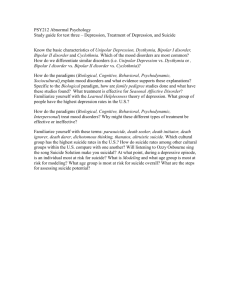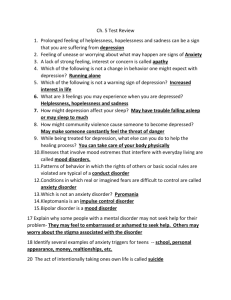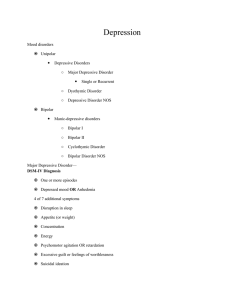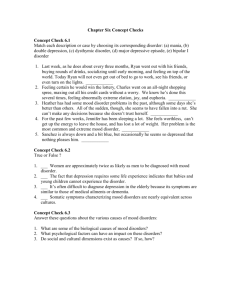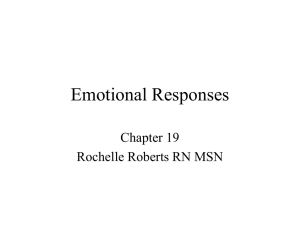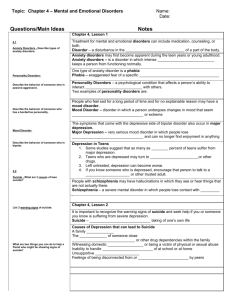All You Wanted to Know About Medications But Were Afraid to Ask
advertisement
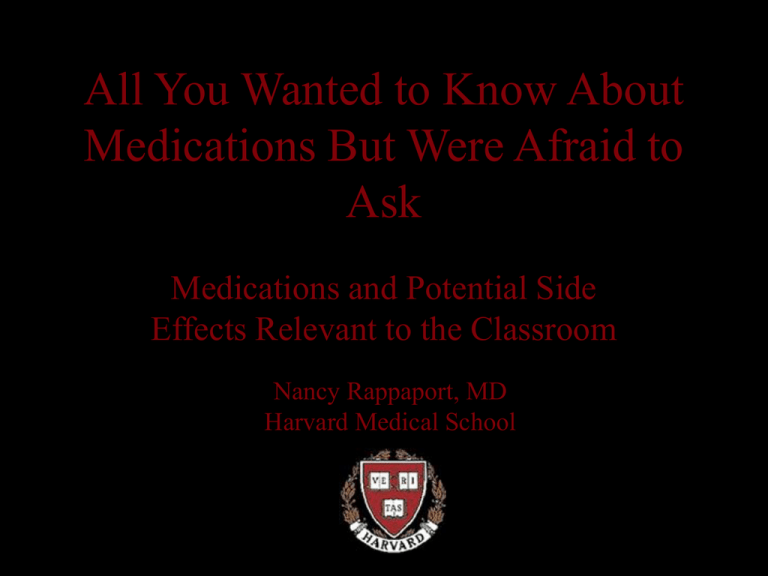
All You Wanted to Know About Medications But Were Afraid to Ask Medications and Potential Side Effects Relevant to the Classroom Nancy Rappaport, MD Harvard Medical School Presentation Goals • To review processes of diagnosis and formulation about kids that may need medication • Relevant information about medications Symptoms of ADHD • Inattentiveness • Distractibility • Impulsivity *Often hyperactivity is considered inappropriate for developmental age children; however, ADHD manifests itself in different ways. ADHD: Core Symptom Areas • Inattention • Impulsivity/Hyperactivity ADHD: Core Symptom Areas • Negative impact on multiple areas of functioning • Social and academic deficits • Patterns of comorbid disorders The Human Brain ADHD • Genetic Origins – – – – – – CNS insults Fetal alcohol syndrome Drug exposure Serious head injury Infection Prematurity • Environmental Factors – E.g., Lead poisoning • Twin Studies • ADHD Studies Is there a simple test to diagnose ADHD? No “Gold Standard” • “How come my son can be so focused when he is playing video games or building a model?” • Observation captures variability • Inefficient performance not an incapacity (lazy) • “When children or adults are distracted they are paying attention to something else. Whether it is soap falling into the bathtub, an apple falling from a tree, or the peculiar way an insect walks across the floor, small attractions may lead to bigger ideas. Being distracted, in other words, means otherwise attracted.” Ellen J. Langer, The Power of Mindful Learning How many children and adolescents have ADHD? • Depends who you ask. • Anywhere from 2-12% of children and adolescents, 4.7% of adults, endorsed childhood and current symptoms of ADHD • On average, at least one child in every classroom Is ADHD a “guy thing?” Problems Communicating • Language impairment in a substantial proportion of community and clinical studies of school-age children with ADHD (20-60% in a clinical study) • Expressive language impaired - word retrieval problems using nonspecific words • Pragmatics - difficulties in the appropriate timing (too much talk with transitions and play settings) • Decreased ability to express when planning or organization (story-telling, group directions) • ADHD and reading disorder (15-30% of ADHD students • More likely with inattention and naming difficulty Game Plan of Evaluation • Core symptoms – Chronicity – Pervasiveness – Impairment and differential diagnosis QuickTime™ and a TIFF (Uncompressed) decompressor are needed to see this picture. • Treatment • Psychoeducation –What ADHD is and is not –“A challenge, not an excuse.” *School interventions *Medications NIMH MTA Study • Medication treatment alone • Medication management and behavioral treatment • Children did better with ADHD symptoms as long as the medication was taken Stimulant Treatment of ADHD • Ritalin • Dextroamphetamine • Amphetamine mixed salts What Medications Will Improve • • • • • • Academic performance Short-term memory Reaction time Cognitive impulsivity On-task behavior Hyperactivity What Medications Won’t Improve • • • • Mood Anxiety Temper Specific learning disorder (no data on speed, accuracy, or reading comprehension) Management of Common Stimulant-Induced Adverse Effects • • • • • Anorexia, nausea, weight loss Insomnia, nightmares Rebound phenomena Irritability Dysphoria, moodiness, agitation Other Medications • Strattera (stomache ache) • Wellbutrin (antidepressant) - takes up to four weeks to get a response • Clonidine - reduces motor activity and impulsiveness (sedation side effect) Mood Disorders Case Histories Disturbing Statistics Fig 1: Developmental and temporal trends in rates of adolescent suicide. Data from Maguire & Pastore (1999). 15 10 10 -14 yea rs ol d 5 15 -19 yea rs ol d 19 96 19 94 19 92 19 90 19 88 19 86 0 19 80 Rate p er 100,000 adolescen ts Fig. 1 Statistics (ctd.) Fig 1.2: Developmental trends since 1950 in suicide rates for 15-19 yr old adolescents, by gender. Maguire & Pastore (1999). 20 15 10 5 0 Male (15-19 yrs) 19 96 19 94 19 92 19 90 Female (15-19 yrs) 19 70 19 50 Rate per 100,000 adolescents Fig. 1.2 • For young people 15-24 yrs old, suicide is the third leading cause of death, behind accidental injury and homicide – 2,000 adolescents 15-19 commit suicide each year • Persons under age 25 accounted for 15% of all suicides in 1997 • Within schools this statistic translates to (in a district of 8,000 students) one suicide a year • Firearms are the most common method for completed suicides, followed by ingestions leading to overdose, and hanging • 65% of completed suicides use handguns. The increase in the rates of youth suicide (and the number of deaths by suicide) over the past four decades is largely related to the use of firearms as a method of destruction • Substance abuse/dependence is the probable reason that adolescence attempts are more lethal • There are 400 suicide attempts by teenage boys for every completed suicide in males • Four thousand suicide attempts per every death in females • Who uses the most effective method – Girls or Boys? • The Center for Disease Control (CDC) has tracked by school survey since 1991 every two years 12,000 to 16,000 students. • Approximately 20% of students have had suicidal ideation; 10% have made a suicide attempt in a 12-month period; 1-3% of teenagers will receive medical attention for an attempt • .01% will be successful • Ideation is almost always episodic Profile of Children with Completed Suicides • Immature problem solving that translates into more impulsive behavior • Less able to tolerate frustration (adult data shows decreased serotonin) • Unable to plan future actions • Aggressive or violent outbursts • Difficulty making decisions • Less able to assess situations realistically than non-suicidal children • Loss of parent before the age of 12 • History of parental abuse • Early onset of suicidal behavior (prepubertal) predicts suicidal behavior in adolescents • Although suicides are rare in children age 12 and under, suicide attempts are NOT rare in bipolar children age 12 and under (20%) • Usually these children are difficult to treat and there is considerable controversy about the criteria as they are referred to as “rapid cyclers and often have mood lability, mood swings, affective storms, irritability and aggressiveness, periodic agitation, explosiveness and severe temper tantrums which can also be in response to trauma and family discord,” (Papolos 1999). Psychological Autopsies • Shaffer studied large numbers of completed suicides at an average age of 16 (170 psychological suicide autopsies) in an ethnically diverse population in 1984-86 interviewing multiple informants with community control subjects. • More than 90% of subjects who committed suicide met criteria for at least one major psychiatric diagnosis • Half of these subjects had psychiatric disorder for at least two years • Link between psychopathology and suicide Organized plan, intent, preparation • One in four adolescents that completed suicides show evidence of planning • According to Shaffer the time-honored clinical inquiry about planning is a poor measure of serious intent Important Implications • Need for thorough diagnostic interview • Never discount a threat especially in the context of affective or substance abuse disorders • Importance of aggressive intervention in first-episode affective illness • The most common diagnostic groups were mood disorders (52% major depression), disruptive disorders and substance abuse • A child with a mood disorder is four to five times more likely to attempt suicide than a child without a mood disorder Completer Profile • Evenly distributed by the SES, evenly distributed by educated vs. uneducated, Western states highest, 60% of firearms • 50% of completers were never in therapy • 75% of completers communicated thoughts about their suicide aloud to several people months before dying (“natural screeners”) Strategies for Suicide Prevention • Suicide awareness programs • Screening • First step of recognition #1 FIND & TREAT ACTIVE DISORDER e.g., Mood disorder, substance abuse, anxiety STRESS EVENT e.g., In trouble with law/school; loss; humiliation ACUTE MOOD CHANGE e.g., Anxiety-dread, hopelessness, anger 1 INHIBITION SOCIAL i.e. MENTAL STATE Slowed down SURVIVAL Adapted from Shaffer & Greenberg, 2002 SUICIDAL IDEATION 2 FACILITATION UNDERLYING TRAIT Impulsive, intense, serotonin abnormality Strong taboo; vailable support; presence of others; difficult to access method #2 STRESS AVOIDANCE/ TOLERANCE #3 CRISIS SERVICES #4 MEDIA GUIDELINES & POSTVENTION SOCIAL Recent example, weak taboo, isolation MENTAL STATE #5 METHOD CONTROL Agitation Method Availability/ Familiarity SUICIDE Types of Depression • Major Depression Usually begins in the late teens, but has been diagnosed in children as young as four • Dysthymia Chronic, mild depression. Starts in childhood and can last decades • Bipolar disorder Older teens cycle between mania and depression. Younger teens can experience both symptoms at once • Clinical vignettes SIGECAPS Sleep - too little or too much lose Interest or pleasure feelings of Guilt or worthlessness decreased Energy decreased Concentration change in Appetite Psychomotor agitation or retardation Suicidal ideation “I don’t care.” “Depression is the mother of anger” • Irritability • Duration of symptoms • Vague, nonspecific physical complaints • Rate of depression varies; with age, the rate of the disorder increases • .3% preschoolers • 1-2% of elementary age boys and girls, 1:1 ratio • 5% of adolescents with a 2:1 ratio of girls to boys Risk Factors • Unresolved grief • Childhood trauma • Learned feelings of helplessness (negative & hopeless) • Anxiety disorder Reprinted with permission Stress and Protection in Different Family Contexts • • • • • • • High levels of conflict “Child is expendable” Inordinate shame or guilt Noble self-sacrifice Deflection away from other conflicts “Stress clusters” Impulsivity and aggression Stress Protection (ctd.) • Ask the family and the patient about how they communicate and see if the patient can identify who she/he relies on when stressed • Assess the family’s capacity to monitor and maintain sufficient watch over the adolescent • Winnicott: “Why not tell him that you know that when he steals he is not wanting the things that he steals but he is looking for something that he has a right to; that he is making a claim on his mother and father because he feels deprived of their love.” Dysthymia • • • • • Less severe form of depression Long-term irritablemood Low in energy Not interested in activities Often precursor of severe depression • Adults often cycle whereas children tend to have longstanding depression with only infrequent, spontaneous remissions. • Difficult to tell if a child is going through a phase or suffering from clinical depression • Spirito’s study drop out ranged from 35%40% for adolescents in treatment after suicide attempts with three visits, 58% to 78% dropped out within nine visits • Be careful of pathologizing kids that they are “resistant” – timing is key and sometimes therapy is used as a form of castigation or shaming by families Treatment • Psychotherapy • Cognitive Behavioral Therapy (CBT) – Focuses on irrational beliefs or distorted thoughts – Learn to identify, test, and correct specific distortions in their thinking – Recognize the relationship between thinking, feelings, and behaviors Medications • SSRI more effective than placebo Serotonin • • • • Distributed widely in the body Discharged by neurons in the brain Regulation of mood Regulation of sleep Medications • • • • • • • • SSRI Prozac Zoloft Celexa Luvox (anxiety) Effexor Wellbutrin Serzone & Trazadone “How long should a doctor treat depression with medication?” • • • • Key: recognize side effects Activation Bipolar switching celebration • • • • • Dimensional issues or comorbid presence Evolving psychopathology Frontal lobe type symptoms (apathy) Gastrointestinal symptoms Sex Bipolar Disorder • Also known as manic depression, a mental illness that causes a person’s moods to swing from extremely happy and energized (mania) to extremely sad (depression) • Chronic illness; can be life-threatening • Most often diagnosed in adolescence Nirvana’s Lithium I'm so happy 'cause today I've found my friends They're in my head I'm so ugly, but that's okay, 'cause so are you... We've broken our mirrors Sunday morning is everyday for all I care... And I'm not scared Light my candles in a daze... 'Cause I've found god - yeah, yeah, yeah I'm so lonely but that's okay I shaved my head... And I'm not sad And just maybe I'm to blame for all I've heard... But I'm not sure I'm so excited, I can't wait to meet you there... But I don't care I'm so horny but that's okay... My will is good - yeah, yeah, yeah I like it - I'm not gonna crack I miss you I'm not gonna crack I love you I'm not gonna crack I kill you I'm not gonna crack Bipolar Disorder (ctd.) • Significant functional impairment • Bipolar I people go through cycles of major depression and mania • Bipolar II similar to Bipolar I except that people have hypomanic episodes, a milder form of mania • Rapid cyclers Mixed Bipolar Disorder • Often unrecognized although also controversial regarding epidemic status • Often misdiagnosed • Often untreated • Often inadequately treated Suicide Risk Factors • 22% of adolescents with completed suicides had bipolar disorder • Family history of suicide • Substance abuse i.e. adolescent with impulse control disorder, depression, suicidality, substance use and access to a weapon is potential for lethality History of Prior Attempts • Males who have made prior attempts are more predictive of completing suicide than females • Only with half of all suicide completers is it verified that they made prior suicide attempts before their death • Repeating an episode within one year of the first attempt range from 14%-26%. • A much debated risk factor of suicidality is whether an adolescent is gay or lesbian. • Russel and Joyner study – Nationally representative data – Are youths who report same-sex sexual orientation at greater risk for suicidal thoughts and suicide attempts than their peers? – Are these youth still at greater risk than their peers after critical adolescent suicide risk factors are taken into account? • Youth with same-sex orientation are two times more likely than their same sex peers to attempt suicide but depression and alcohol use are precursors to suicidality. • 85% of same-sex orientation teenagers have not considered suicide at all (72% of females 85% of males) Impact of Cultural Factors • Suicide risk of African Americans rose dramatically after 1986 but since then rates have declined. • Heritage/Cultural Factors • Internalization of racist stereotypes that may have led to the rise in self destructive behavior • High rates of homicide and substance abuse among blacks; self destructive behavior • Expressions of rage are turned inward or outward • Skepticism/fearful of the medical establishment • “From the cradle to the pulpit to the grave, many blacks are taught that suffering on earth leads to great rewards in the afterlife.” Epidemiology of Bipolar Disorder • Prevalence: 1% of population Adults = Adolescents • Males = Females • 2-3 million American adults are diagnosed with bipolar disorder • NIMH estimates that one in very one hundred people will develop the disorder Controversy • • • • Severity and duration Onset before puberty is estimated to be rare Peak between 15-19 years old Retrospective study of adults Assessment/Diagnosis of Bipolar Disorder • Often very complicated; it mimics many other disorders and has comorbidity (presents with other disorders) • Alphabet soup diagnosis • Half of bipolar children have relatives with bipolar disorder • Atypical presentation in juvenilesexacerbation of disruptive behavior, moodiness, low frustration tolerance, explosive anger and difficulty sleeping at night • ADHD confusion although identifying presence of mood disorder helpful in guiding treatment • Comorbidity of ADHD/BPD more severe presentation, often severe affect dysregulation, marked impairment, violent temper outbursts DIGFAST – Mental Status Exam • • • • • • • Distractible Insomnia Grandiosity/Super-hero mentality Flight of ideas Activities that are dangerous or hypersexual Speech is rapid Thought insertion • Major depression often presents first (estimated that 20 - 40% of children presenting with major depression within 5 years will be bipolar) • Comorbidity • 70 - 90 % of adolescents have other disorders • ADHD, Conduct Disorder, Substance abuse Medications • • • • Mood Stabilizers Lithium Divalproex Sodium (Depakote) Carbamezapine Newer Agents • • • • • Neurontin Lamictal Topamax Gabatril Atypical antipsychotics Key Point • Just because a child improves on a mood stabilizer does not prove the diagnosis. Mood stabilizers have been used for a long time to help with aggression in children Multiple Modalities • • • • • • • • Psychotherapy Psychoeducation/Support School Support/Consultation Residential Placement, Acute Hospitalization -Mood Charting -Teach Good Sleep Hygiene Legal intervention Hope Post Traumatic Stress Disorder • Hyperarousal (most common symptom; startled response, behavioral irritability, sleep disturbances, regulatory functions off, hypervigilance, emotional numbing, or dissociation) • Nightmares • Flashbacks • Upsetting reminders and triggers Active Avoidance Passive Avoidance • Fight or Flight response alarm reaction then fear (experience in the high school, sometimes inappropriate escalating behavior by adults to child’s apparent impertinence) Trauma: Common Ways of Thinking • • • • • • “All or nothing” “Again and Again” “Must”, “Should”, or “Never” “End of the world” Always blaming yourself Thinking on the downside • Secondary attachment figure • Ross Greene material PTSD • No particular medication • Low doses of SSRI if depression and anxiety present • Risks/benefits Obsessive-Compulsive Disorder • Persistent ideas or impulses • Purposeful repetitive behaviors, compulsions • Behavioral treatment, cognitive therapy with symptom immersion very useful • SSRIs are useful, sometimes in relatively high doses Wait, by Galway Kinnell Wait, for now. Distrust everything, if you have to. But trust the hours. Haven't they carried you everywhere, up to now? Personal events will become interesting again. Hair will become interesting. Pain will become interesting. Buds that open out of season will become lovely again. Second-hand gloves will become lovely again, their memories are what give them the need for other hands. And the desolation of lovers is the same: that enormous emptiness carved out of such tiny beings as we are asks to be filled; the need for the new love is faithfulness to the old. Wait. Don't go too early. You're tired. But everyone's tired. But no one is tired enough. Only wait a while and listen. Music of hair, Music of pain, music of looms weaving all our loves again. Be there to hear it, it will be the only time, most of all to hear, the flute of your whole existence, rehearsed by the sorrows, play itself into total exhaustion
